Second Week in Kampala: So much to do, so little time!
Week two in Uganda and, much like the first week, I had the opportunity to do and see so much in Uganda: my first site visit for my internship, a night at the Ndere Cultural Center, a trip to Munyonyo, and a visit to the Uganda Wildlife Education Center in Entebbe. Looking back on each week, it amazes me that, although I’m working full time, I’m still able to experience so many new things every day.
These new experiences aren’t limited to time outside of work, either. One of the SAFE Program’s integral roles is to oversee and assist the grantee partners with their work in the local communities. Component I of the SAFE Program, or the Access to Justice portion of the Program, focuses on improving the management of land-related disputes as well as creating awareness of the land tenure and land administration systems. The grantee partners under Component I work with local communities, helping them to learn what their rights and responsibilities are with respect to land ownership. This past week, Component I attended a “sensitization” program in the Busukuma sub-county of Wakiso District facilitated by Caritas Justice and Peace Department (CJ&P). In Uganda, sensitization means education. When we arrived, the local community members were arranged underneath a tree in an open field waiting to hear CJ&P’s presentation. Although the presentation was given in the local language, a member of the Component I team interpreted for me and Emily so we were able to follow along.
Uganda possesses a variety of land tenure systems. In the central region, where Wakiso District is located, the land typically falls under the mailo land tenure system. The mailo land tenure system separates ownership of the physical land from occupancy or ownership of any developments on the land. Under the Land Act of 1998, mailo owners possess all the same benefits and powers of a freehold owner, however, mailo owners cannot use their power against the interests of bona fide or lawful occupants (the “kibanja” holder) of the mailo owner’s land. What this means is that the kibanja holder and his or her successors are statutorily protected from eviction as long as they pay the prescribed ground rent to the land owner. Further, the kibanja holder possesses the right of first refusal should the mailo land owner wish to sell his land.
Many people who occupy mailo land may be unaware of both their rights to continued occupancy or their responsibility to pay ground rent to the mailo land owner. The purpose of programs like the one held by CJ&P is to address this knowledge gap. Observing the increased understanding displayed by the community following the presentation and their growing desire to protect their land and livelihoods was an exciting moment. By the end of the presentation, every community member expressed an interest in creating a will to protect their family’s continued occupancy or ownership of their land. Programs, much like CJ&P’s, occur in villages around Uganda. Fortunately, due to SAFE’s work, I was able to experience the tangible result of such educational efforts.
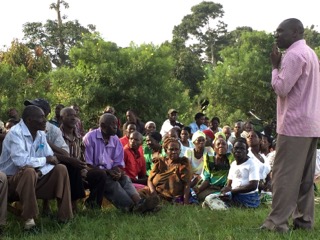
Outside of work, I also visited a number of other sites in and around Kampala. Last Sunday, we visited the Ndere Cultural Center, home of the Ndere dance troupe. The troupe performs cultural dances around Uganda, Rwanda, and Burundi. The dancers were incredible but the best part of the event was watching audience members join in the dances from their village. The strong cultural ties possessed by Ugandans was on full display at Ndere.
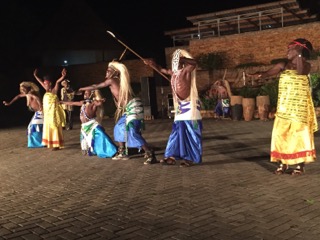
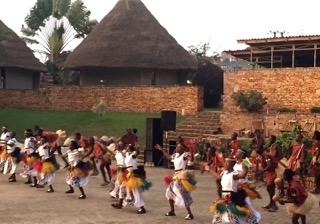
On Tuesday, in celebration of the second public holiday, we spent the afternoon at Munyonyo on the banks of Lake Victoria. Munyonyo is a resort on the outskirts of Kampala that offers a hotel, swimming, and a beautiful lake view with a large field where numerous soccer games were going on throughout the afternoon. Emily and I enjoyed a full fried fish, which was absolutely delicious! The bird in the background (a marabou stork) was only one of the numerous storks surrounding us while we enjoyed our fresh fish.
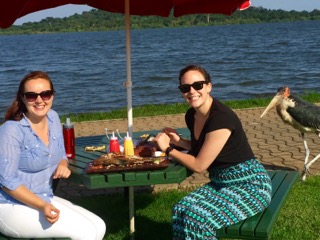
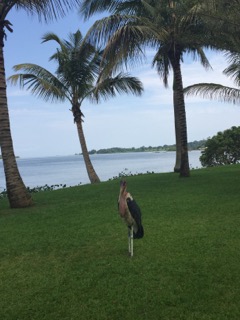
As the end to an eventful week, we also visited the Uganda Wildlife Education Center (UWEC) in Entebbe, about an hour outside of Kampala. The zookeepers at UWEC also serve as tour guides, and we were fortunate enough to have a wonderful guide, Paul, who gave us more information about the animals than I learned in all my years of school. Paul knew each animal by name and, by the way the animals responded to his voice, it was clear they knew him as well. UWEC was far and away one of the best zoo visits I’ve had.

Next week offers just as much to do as the previous week. Emily and I will be leaving on Tuesday to travel to Jinja to attend a training for conflict monitors. The conflict monitors assist SAFE with monitoring and reporting potential conflicts all over Uganda. They serve an integral function for the SAFE Program. I’m excited to learn more of what they do and what their training consists of. Jinja also offers numerous other opportunities to explore as it’s located where the Nile flows out of Lake Victoria. With all of the places to visit and sites to see, I feel as if the remaining eight weeks in Uganda will not be enough time to accomplish everything!